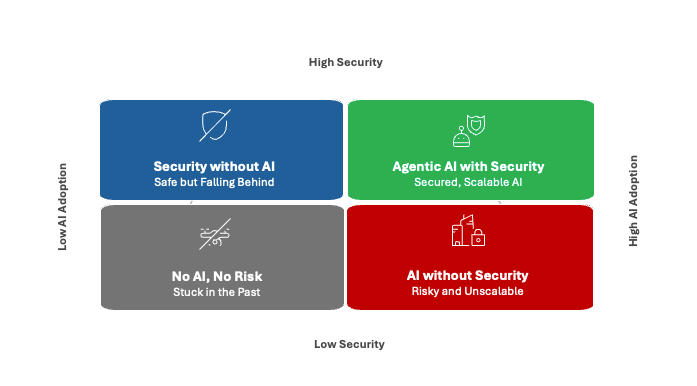The Four Quadrants of AI: Why Security Will Define the Winners of the Agentic Era
From billboards to boardroom decisions, AI is everywhere—but without governance and guardrails, most initiatives wouldn't be able to scale in production.
Last weekend, I was carpooling with my cofounder to San Francisco for an event, he casually pointed out one of the billboards along Highway 101—a familiar company prominently showcasing its AI initiatives. As the freeway elevated, these billboards felt impossibly close, almost as if the future of AI was vividly unfolding right beside us.
I've always loved these billboards next to 101 – prime real estate for corporate branding, right in the thick of Silicon Valley, visible to packs of investors, early adopters, and technologists. They offer a fascinating glimpse into current market trends. Yesterday, driving down to our San Jose office, the usual traffic crawl near Palo Alto gave me ample time to notice again. Out of curiosity, I started counting and realized almost two out of every three billboards had something to do with AI.
The High-Stakes Equation: $15.7T in Growth, $10.5T in Risk
Clearly, everyone is racing into AI, driven by excitement, urgency, and the promise of transformation. AI isn't the future—it's the present.
PwC’s landmark "Sizing the Prize" report projects that AI could add $15.7 trillion to the global economy by 2030. But here’s the other side of that equation: Cybersecurity Ventures estimates that cybercrime damages will reach $10.5 trillion annually by 2025—and unsecured AI will only accelerate that trend. Scaling AI securely is no longer a side quest—it’s the defining challenge for modern enterprises.
The Four Quadrants of AI and Security
If we map today’s AI and security landscape by adoption levels, we land on four distinct quadrants:
Grey Quadrant: No AI, No Risk – Stuck in the past
At first glance, this seems like the safest option. But avoiding AI altogether means stagnation. Most businesses already recognize AI’s value and potential—it’s not about if, but when. Ignoring AI won’t stop the market from evolving—it just means evolving without you.
Blue Quadrant: – Secure but Falling Behind
This quadrant does not really make sense. It's hard to imagine any business investing heavily in security around AI without adopting the technology. Security for its own sake doesn't move the needle. You can’t protect what you haven’t built.
Red Quadrant: AI without Security – Fast, Fragile, and Costly
This is where most businesses are landing today. The adoption of AI is skyrocketing, but security practices haven’t caught up. This quadrant is a ticking financial time bomb. Without the right guardrails, AI systems can expose businesses to catastrophic breaches, operational failures, regulatory violations, and reputational damage. And yet, according to IDC study every dollar spent on AI security has shown to return up to $8 in productivity gains. The financial and operational risks of inaction are simply too great to ignore.
Green Quadrant: Agentic AI with Security—The Skyrelis Zone
It’s not the AI itself—most teams have figured that part out. The real challenge is governance: managing and controlling agentic AI systems at scale. Autonomous agents aren’t just tools—they’re capable of completing tasks, making decisions, and evolving over time. That dramatically raises the bar for security.
To support them in production, IT and security teams need runtime visibility, dynamic policy enforcement, and control at the moment of action. Without that, the risk of unintended consequences grows with every new agent deployed.
Agentic AI will transform how businesses operate—but without real-time governance and security, it won’t scale in production.
The winners will be those who adopt AI with control—who build not just agents, but accountability.
Beyond a Feature Gap: Why Agentic Security Is Its Own Category
This week alone, I received three direct messages and saw more posts in my LinkedIn feed—all reacting to the same stat: Gartner predicts that over 40% of agentic AI projects will be canceled by the end of 2027, citing escalating costs, unclear business value, or inadequate risk controls. It’s a wake-up call, but not a surprising one.
AI alone isn’t a silver bullet. It doesn’t create value just by itself—it creates value by solving real problems. Yes, defining cost structures and business value can be challenging, but they're familiar problems. Most enterprises have frameworks, models, and financial levers in place to work through ROI and budgeting.
But agentic security is different—it’s an emerging field. This isn’t just a feature gap; it’s a category gap. Unlike network security, application firewall, Agentic Security requires entirely new approaches: dynamic policy layers, runtime oversight, and controls that are responsive to autonomous behavior. This is uncharted territory for most enterprises—and it’s why many projects stall not at the idea or the pilot phase, but when it’s time to scale securely in production.
Securing What Comes Next
The potential of agentic AI is massive—and the hype exists for a reason. But realizing that potential takes more than excitement. It takes planning, tools, and trust.
This moment feels a lot like the early days of SaaS—except it’s bigger. We’re not just building software; we’re building systems that think, decide, and act. Agentic AI marks a shift from static tools to dynamic, autonomous decision-makers. And with that, the stakes are exponentially higher.
In this new era, security isn’t a checkbox—it’s the competitive edge. It will determine who is the winner – the organization can scale safely and sustainably, and which ones get sidelined by risk, regulation, or public trust.
So what kind of security does agentic AI really need? What solutions exist today? And more importantly—how do we cut through the noise to evaluate the right security measures for this next wave of AI? That’s exactly what I’ll explore in my next blog. Bottom of Form





